
by Daniel J. Leonard | Nov 17, 2016

Ginkgo
Florida has so much to offer! It is home to the world’s most beautiful beaches. It has one of the largest agricultural economies nationwide.
But among all these things, Florida is lacking in one area that is very noticeable come fall: all the beautiful red, yellow, and orange leaf colors that paint the autumn landscape just a few hours to the north!
As frustrating as the lack of fall color in Florida’s native forests may be, this situation is easily amended in yards throughout the state by planting some autumn color standouts! Here are three of the very best for Northwest Florida:
This holdover from the Jurassic Period (Literally! Fossil records indicate Ginkgo has existed virtually unchanged for well over 100 million years!) has much to offer as an ornamental tree, including spectacular golden-yellow fan-shaped leaves in fall! Somewhat ungainly in youth, a mature Ginkgo is truly a sight to behold, an 80-100’ tall, imposing specimen. Ginkgos are very tolerant of all soil conditions except waterlogged, have few insect and disease pests, and are remarkably drought-tolerant once established. Be sure to select a male cultivar however, as female trees produce extremely odiferous seeds that remarkably resemble rancid butter!
- Chinese Pistache (Pistacia chinensis)
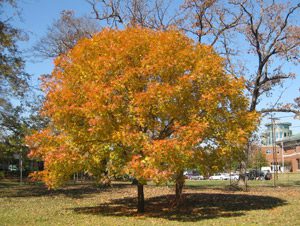
Chinese Pistache
A little-known, much underused tree in the Deep South, Chinese Pistache will light your landscape aflame with brilliant, orange-red fall foliage. One of the last trees to turn color in the fall, Chinese Pistache can help extend the show deep into November! It is a small to medium sized tree that will not overwhelm any but the smallest landscapes. As with Ginkgo, the habit of the tree in youth is awkward at best and the tree’s full potential is not realized until maturity when it becomes a dense, oval-round specimen. Chinese Pistache is close to bulletproof, tolerant of drought and poor soil conditions.
- Black Gum (Nyssa sylvatica)
One of Northwest Florida’s best native trees for fall color is Black Gum. Black Gum is a standout tree, pretty in all seasons, possessing dark, almost-black bark, a tall pyramidal habit and vivid fall foliage in the deepest shades of red and purple. As a bonus, Black Gum usually begins its color change very early, occasionally in September. The addition of this tree to a lawn dominated landscape can deliver at least an extra month of color! Black Gum prefers moist, deep soils but is found in dry flatwoods and swamps alike, betraying its adaptability.
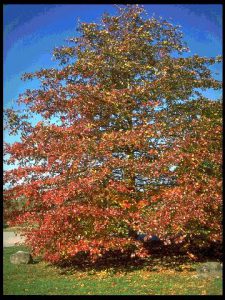
Young Black Gum Tree
Including the above trees in new or existing landscapes is an easy, smart way to extend the fall color show from September through November and make home gardeners long a little less for the colorful northern autumns! Happy Gardening!
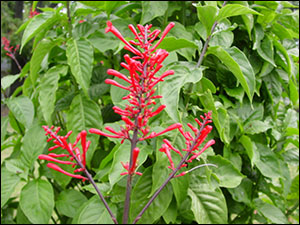
by Sheila Dunning | Nov 7, 2016
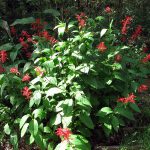 Looking to add something to brighten your landscape this autumn? Firespike (Odontonema strictum) is a prolific fall bloomer with red tubular flowers that are very popular with hummingbirds and butterflies. It’s glossy dark green leaves make an attractive large plant that will grow quite well in dense shade to partial sunlight. In frost-free areas firespike grows as an evergreen semi-woody shrub, spreads by underground sprouts and enlarging to form a thicket. In zones 8 and 9 it usually dies back to the ground in winter and resprouts in spring, producing strikingly beautiful 9-12 inch panicles of crimson flowers beginning at the end of summer and lasting into the winter each year. Firespike is native to open, semi-forested areas of Central America. It has escaped cultivation and become established in disturbed hammocks throughout peninsular Florida, but hasn’t presented an invasive problem. Here in the panhandle, firespike will remain a tender perennial for most locations. It can be grown on a wide range of moderately fertile, sandy soils and is quite drought tolerant. Firespike may be best utilized in the
Looking to add something to brighten your landscape this autumn? Firespike (Odontonema strictum) is a prolific fall bloomer with red tubular flowers that are very popular with hummingbirds and butterflies. It’s glossy dark green leaves make an attractive large plant that will grow quite well in dense shade to partial sunlight. In frost-free areas firespike grows as an evergreen semi-woody shrub, spreads by underground sprouts and enlarging to form a thicket. In zones 8 and 9 it usually dies back to the ground in winter and resprouts in spring, producing strikingly beautiful 9-12 inch panicles of crimson flowers beginning at the end of summer and lasting into the winter each year. Firespike is native to open, semi-forested areas of Central America. It has escaped cultivation and become established in disturbed hammocks throughout peninsular Florida, but hasn’t presented an invasive problem. Here in the panhandle, firespike will remain a tender perennial for most locations. It can be grown on a wide range of moderately fertile, sandy soils and is quite drought tolerant. Firespike may be best utilized in the
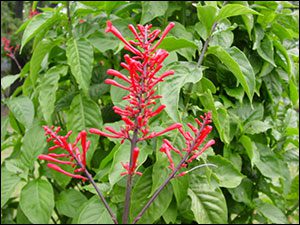
Image Credit UF / IFAS Gsrdening Solutions
landscape in a mass planting. Plants can be spaced about 2 feet apart to fill in the area quickly. It is one of only a few flowering plants that give good, red color in a partially shaded site. The lovely flowers make firespike an excellent candidate for the cutting garden and is a “must-have” for southern butterfly and hummingbird gardens. Additional plants can be propagated from firespike by division or cuttings. However, white-tailed deer love firespike too, and will eat the leaves, so be prepared to fence it off from “Bambi”.

by Sheila Dunning | Oct 7, 2016

Monarch butterfly on dense blazing star (Liatris spicata var. spicata).
Beverly Turner, Jackson Minnesota, Bugwood.org
Each fall, nature puts on a brilliant show of color throughout the United States. As the temperatures drop, autumn encourages the “leaf peepers” to hit the road in search of the red-, yellow- and orange-colored leaves of the northern deciduous trees.
In Northwest Florida the color of autumn isn’t just from trees. The reds, purples, yellow and white blooms and berries that appear on many native plants add spectacular color to the landscape. American Beautyberry, Callicarpa americana, is loaded with royal-colored fruit that will persist all winter long. Whispy pinkish-cream colored seedheads look like mist atop Purple Lovegrass, Eragrostis spectabilis and Muhlygrass, Muhlenbergia capillaris.
The Monarchs and other butterfly species flock to the creamy white “fluff” that covers Saltbrush, Baccharis halimifolia. But, yellow is by far the dominant fall flower color. With all the Goldenrod, Solidago spp., Narrowleaf Sunflower, Helianthus angustifolius and Tickseed, Coreopsis spp., the roadsides are golden. When driving the roads it’s nearly impossible to not see the bright yellows in the ditches and along the wood’s edge. Golden Asters (Chrysopsis spp.), Tickseeds (Coreopsis spp.), Silkgrasses (Pityopsis spp.), Sunflowers (Helianthus spp.) and Goldenrods (Solidago spp.) are displaying their petals of gold at every turn. These wildflowers are all members of the Aster family, one of the largest plant families in the world. For most, envisioning an Aster means a flower that looks like a daisy. While many are daisy-like in structure, others lack the petals and appear more like cascading sprays.
So if you are one of the many “hitting the road in search of fall color”, head to open areas. For wildflowers, that means rural locations with limited homes and businesses. Forested areas and non-grazed pastures typically have showy displays, especially when a spring burn was performed earlier in the year. Peeking out from the woods edge are the small red trumpet-shaped blooms of Red Basil, Calamintha coccinea and tall purple spikes of Gayfeather, Liatris spp.
Visit the Florida Wildflower Foundation website, www.flawildflowers.org/bloom.php, to see both what’s in bloom and the locations of the state’s prime viewing areas. These are all native wildflowers that can be obtained through seed companies. Many are also available as potted plants at the local nurseries. Read the name carefully though. There are cultivated varieties that may appear or perform differently than those that naturally occur in Northwest Florida. For more information on Common Native Wildflowers of North Florida go to http://edis.ifas.ufl.edu/ep061.
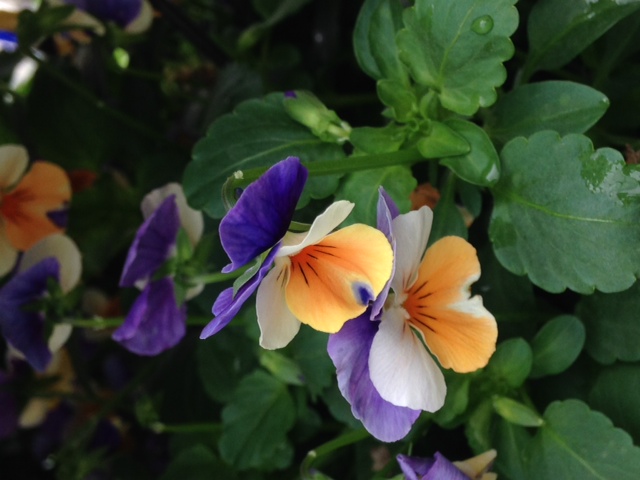
by Julie McConnell | Nov 24, 2015
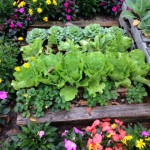 You may have heard “group plants with similar needs together” but struggled to come up with some combinations that work. The most important things to consider when creating functional garden space is the cultural needs of the plants you want to combine. Sunlight, water, and fertilizer needs should be very similar when planting multiple plants together. For fall and winter gardens, choose annuals that are frost tolerant and/or evergreen perennials.
You may have heard “group plants with similar needs together” but struggled to come up with some combinations that work. The most important things to consider when creating functional garden space is the cultural needs of the plants you want to combine. Sunlight, water, and fertilizer needs should be very similar when planting multiple plants together. For fall and winter gardens, choose annuals that are frost tolerant and/or evergreen perennials.
Here are some plants that work well together in cool weather:
- Strawberries and romaine lettuce – both are cool season annuals that can be planted in late October or early November. The lettuce can be harvested from outside leaves after growth begins or let it form a head and cut the entire plant. Strawberries will spread out but remain fairly low growing compared to the upright lettuce. These plants combine well in a container if given room to expand.
- Rosemary and oregano – these culinary herbs thrive in sunny, well-drained spots. Rosemary is an upright woody perennial and oregano spreads along the ground making a fragrant groundcover for a tough spot.
- Snapdragons, pansies, and parsley – this combination gives foliage contrasts in addition to colorful flowers. This combination will work in full sun or a slightly shaded spot in th
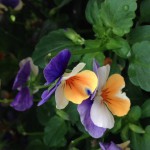 e garden. In the spring, replace the snapdragons and pansies for warm season annuals for continued color.
e garden. In the spring, replace the snapdragons and pansies for warm season annuals for continued color.
- Cabbage, cauliflower, and strawberries – all cool season edible crops that have attractive foliage and similar needs.
- Snapdragons, violas, and petunia – this colorful combination has three height levels of tall snaps, bunching violas, and trailing petunias.
To learn more about these plants and other options Growing Strawberries in the Florida Home Garden, Herbs in the Florida Garden, and Gardening with Annuals in Florida.
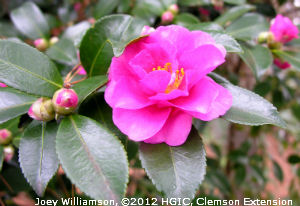
by Sheila Dunning | Nov 18, 2015
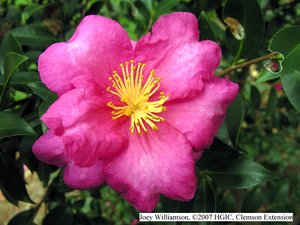
Camellia sasanqua ‘Kanjiro’ at the South Carolina Botanical Garden
Camellia sasanquas begin blooming this month. Their three-inch diameter blossoms of pink, white, rose or red displayed over glossy, dark green foliage will come into their full glory in November. This robust and stylish aristocrat of the garden is often passed by in favor of its familiar cousin, Camellia japonica. While it’s true that the “japonicas” have larger flowers, Camellia sasanqua has just as many endearing attributes. Like the japonicas, sasanquas have been selected and hybridized into dozens of forms that vary immensely in flower color, size and shape. With a variety of growth habits from dwarf and spreading to narrow and upright, their ability to thrive in part sun or shade, sasanquas are one of the most versatile landscape plants.
Sasanquas bear profusions of flowers in fall and early winter depending on cultivar and location. In general they blossom before Camellia japonica. Sasanquas have mature heights that range from 4-15 ft. The taller cultivars are typically trimmed up as small trees. Other cultivars remain shrubby and limited in height. Their small foliage makes them suitable subjects for formal pruning, although they are quite attractive when allowed to grow naturally. Several sasanqua varieties are ideal for creating dramatic espaliers when trained on fences and walls. Like other cool weather bloomers, sasanquas bloom over a much longer period than most spring and summer plants with buds opening over a three-month period. The blossoms shatter easily and create colorful carpets of petals on the ground, adding to their garden impact. Even when not in bloom the sasanquas make a statement with their beautifully glossy, rich green leaves that excel at providing backdrops for garden neighbors.

Camellia ‘Vernalis Yuletide’ at the South Carolina Botanical Garden

Camellia sasanqua ‘Shishi Gashira’ at the South Carolina Botanical Garden
Sasanqua camellias are native to China and Japan. They prefer rich organic acid soils (the same as azaleas and gardenias). Provide plants with organic mulch such as leaf litter or shredded bark. Broken shade is preferred but sasanquas will tolerate more sun if watered well. Consistent watering is important to continuous blooming. If the experience drought conditions the buds will dry and fall without opening.
Select sasanqua varieties based on what you want them to do in your garden. ‘Shishi-Gashira’ is a dwarf, low spreading plant that is suited well for foundation plants and container specimens. Other compact varieties include the more upright ‘Yuletide’ whose fiery red blossoms are accented with bright yellow stamens and the double rose ‘Bonanza’ which begins flowering in September with flowers that rival the japonica varieties in size and form. If you need larger and faster growing plants for hedges, screens or small specimen tree, consider the white ‘Snow on the Mountain’, double pink ‘Pink Snow’ or pale, shell pink ‘Jean May’. ‘Kanjiro’ and ‘Daydream’ are vigorous upright pink varieties whose single flowers are fragrant.
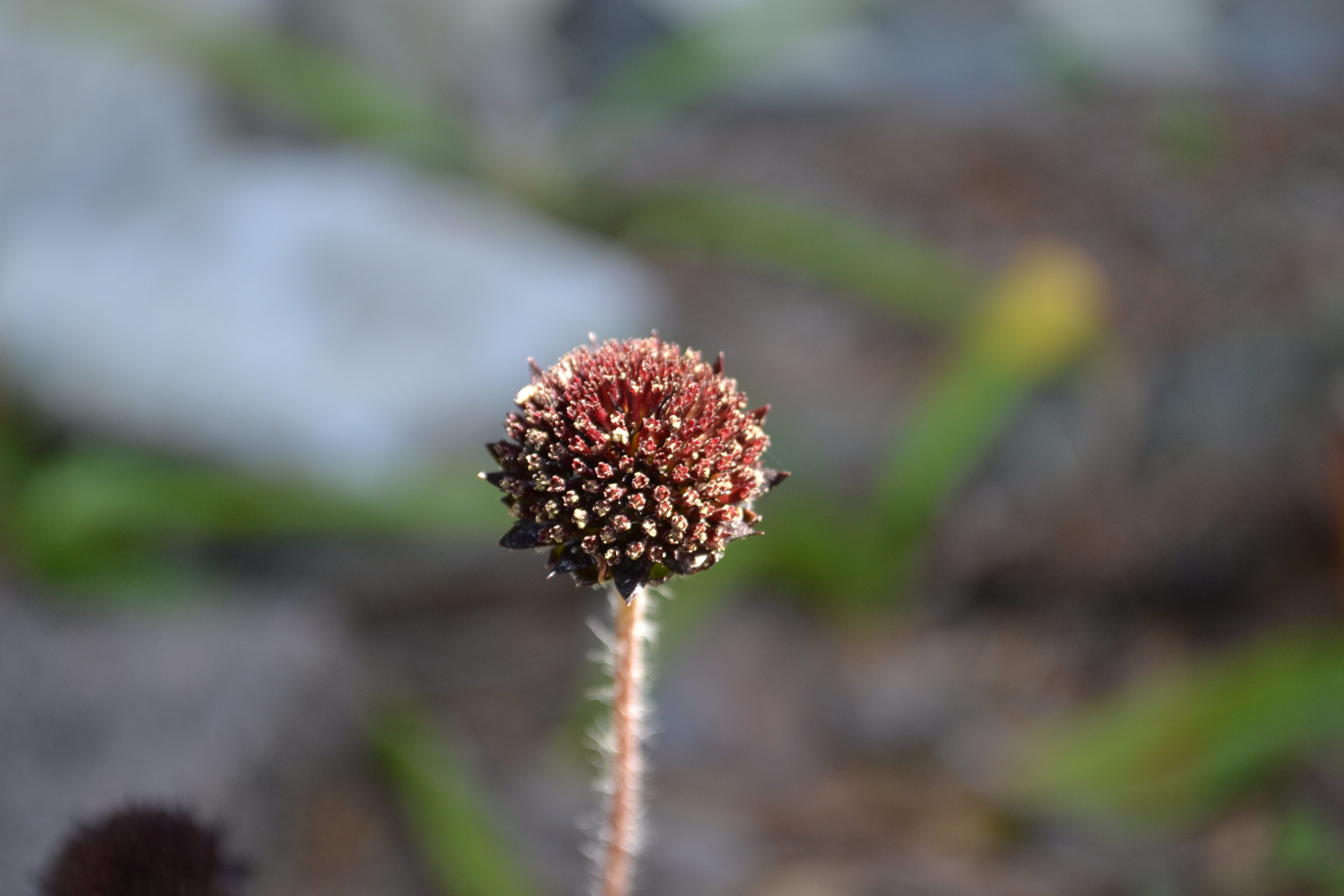
by Beth Bolles | Oct 27, 2015
Fall is a wonderful season for viewing wildflowers and there are many flower colors brightening our landscapes and roadsides. Amongst all the color there is one wildflower, the Rayless sunflower (Helianthus radula) that may not be nearly as showy but is very interesting in the landscape.
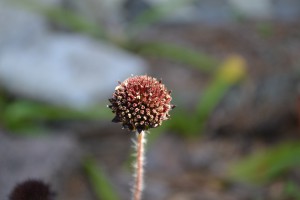
Flower heads have disk flowers but no rays. Photo by Beth Bolles
Many people will discover the Rayless sunflower in a moist area near the ditch or a drainage area. It has a basal set of leaves that blend into the surrounding grass. In summer a leafless stem about will emerge that is topped by a round flower with discs but no rays. It mostly appears brown but may offer a tinge of red or purple from the disc flowers.
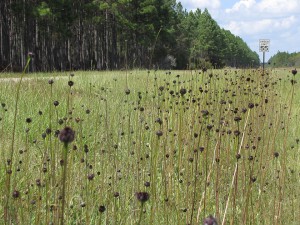
Rayless sunflower in mass. Photo by Jeff Norcini
Not everyone will appreciate the beauty of the rayless sunflower. It will be visited by pollinators and offers an attractive contrast to the greens of surrounding plant material. It is a plant suited to its preferred habitat and an understated treasure among native wildflowers.











 e garden. In the spring, replace the snapdragons and pansies for warm season annuals for continued color.
e garden. In the spring, replace the snapdragons and pansies for warm season annuals for continued color.




